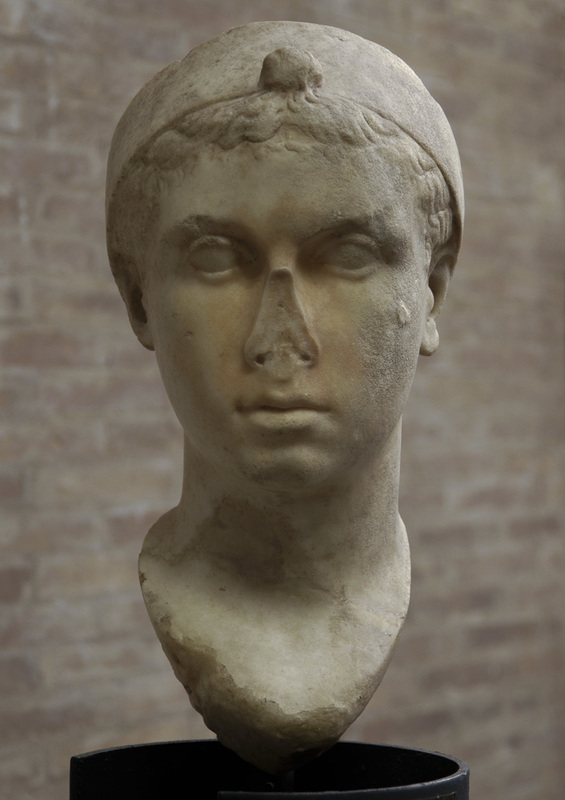Vatican Cleopatra
Title
Date
Artist or Workshop
Materials
Height of the work
Provenience
Current Location
Description and Significance
Description:
The Roman marble portrait bust known as the “Vatican Cleopatra,” depicts the neck and head of a female figure. As with other female portraits of the Roman Republican period, the figure has a youthful, idealizing oval face with smooth skin, gently curved eyebrows, and a small, full-lipped mouth. Her eyes are large and almond-shaped, and her chin is gently rounded below the mouth. She stares vacantly into the distance, retaining a calm and serene expression that recalls female portraiture found in the Greek Hellenistic period. On the surface of the left cheek, there is a small fragment of marble that extends slightly above the plane of the face. The figure wears the Greek “melon coiffure” of evenly divided braids beginning at the crown of the head and extending to the nape. The braids are gathered into a knot on the back of the head and tied, similar to the knot of hair on top of the head in portraiture of the Greek goddess Aphrodite. Around the head, the figure wears a wide diadem that drapes under the bottom of the knot on the back of the head. On the front of the diadem above the forehead, the figure has a broken nub of marble that has been suggested by scholars to be the piece of a lotus crown or a uraeus, the royal cobra, a characteristic mark of the Egyptian pharaohs.
Significance:
Despite Cleopatra VII’s connection to both Julius Caesar and Marc Antony of the Roman Empire, depictions in-the-round of the Hellenistic Egyptian queen of Roman origin were rare. Until the period of the early 1930s, the portrait of the “Vatican Cleopatra” was understood as a representation of a priestess of Ceres rather than Cleopatra VII—the head had been placed into a body recovered from the same villa, and the two objects were presented together incorrectly for almost two hundred years. A German archaeologist first recognized the inconsistency of the image of the head featured with the body of a priestess, noting that the head bore a resemblance to coin portraits of Cleopatra VII found in Rome and Alexandria. The nose, which had been restored in the 1800s but removed later because of its incorrect alignment with the face, mimicked the hooked quality of the nose shape shown of the figure in her lifetime coin portraits across the empire. Though much has been learned of the “Vatican Cleopatra,” the sculpture still leaves many questions unanswered regarding its placement, use, and function during Roman times. Since its recognition as a portrait of Cleopatra VII, many scholars have suggested, by reviewing the writings of the Roman historian, Appian, that the face is a copy of a full-length gold sculpture dedicated by Julius Caesar to Venus Genetrix. Venus Genetrix was the Julio-Claudian line’s version of the goddess Venus, and most importantly, Caesar’s ancestor, therefore making the significance of Cleopatra VII being represented alongside the goddess more emblematic of her importance in the familial line of the Julii. The original sculpture could have been placed in the temple alongside a sculpture of Venus, one of Julius Caesar, and possibly one including the couple’s son, Caesarion. Some have identified the small piece of marble on the figure’s face as being an indication of Cleopatra rendered in the role of Venus: it is possible that the child Caesarion was represented as the god Eros, Venus’ son, sitting on the shoulder of his mother with one hand resting gently on her cheek. Other scholars, however, have interpreted the excess piece of marble simply as a mark utilized by the artist during carving that was never fully rendered. Though a depiction of Cleopatra VII in the guise of Venus would have served as a symbolic maternal representation of the queen, no ancient sources describe the original gold statue of the Temple of Venus Genetrix in detail or mention a portrait completed of Cleopatra VII as a goddess during her time in Rome.
References
Ashton, Sally-Ann. "Archaeological Traces of Cleopatra in Rome." Cleopatra and Egypt, Malden, Blackwell, 2008, pp. 57-60. Print.
Dillon, Sheila. "The Female Portrait Face." The Female Portrait Statue in the Greek World, New York, Cambridge UP, 2010, pp. 114-15. Print.
Kleiner, Diana E. E. Cleopatra and Rome. Cambridge, Belknap Press of Harvard UP, 2005, pp. 203-204; 218-219. Print.
Robins, Gay. "Royal Women and Queenship." Women in Ancient Egypt, Cambridge, Harvard UP, 1993, pp. 23-24. Print.
Contributor
Citation
Item Relations
This item has no relations.

